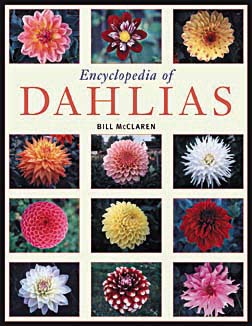|
Feb. 10, 2005
Why we love dahliasby AMY STEWART WHEN I GOT TIMBER PRESS' Encyclopedia
of Dahlias in the mail, I thought, well, they've gone and
done it. They've printed up dahlia porn, and now they're distributing
it on the Internet. It's only a matter of time before the feds
show up and shut them down. There may be some words in this book, but all I could do was flip through the pages, ogling one up-front, in-your-face flower shot after another. At first I was disappointed that there were not more photos depicting dahlias growing in a garden with other flowers, but soon I ceased to care. Who needs a plot, anyway? The freckled `Rolf' dahlia, with its finely feathered markings of red and yellow, drew me in, and the crazy twisted petals of `Camano Classic' got me hooked. I ignored the captions. I ceased to care about how they would fit into my garden. Just show me more dahlias, baby. I'm not sure what it is about dahlias that inspire this kind of lust, but I've got a pretty good guess. The flowers are incredibly versatile, ranging in size from a modest little daisy-shaped blossom to an overblown dinner plate-sized whopper. They come in every color but blue, and that's a pretty impressive range. They make great cut flowers. And they are stubbornly seasonal, which means that you're stuck spending a fair part of the year waiting for them. The anticipation is half the fun. Eventually I realized that this showy hardcover book by dahlia hybridizer and grower Bill McClaren did have words in addition to pictures. That only made it worse. Consider this description of `Orange Flame,' a wild and frilly AA dahlia with split and curvy tangerine-colored petals. (In the world of dahlias, as opposed to -- well, never mind -- the largest dahlias are called `AA size' and smaller flowers are `B size' or `miniature.') Anyway, the description includes this warning: "The bloom is often too large for the stem to support, making the flower side facing." Well, that's a real drawback. I hate it when a flower is too large to even stand up on its own. Excuse me while I go order a couple dozen of them. This book is clearly for the show growers, the county fair and dahlia society set, and as such. It's a bit out of my league. The flower descriptions often include such statements as "Wins in its competitive Class, Cream of the Crop, and Fabulous Fifty," whatever that means. But don't worry about that -- just use this book as the guide to finding your dream dahlia, and then turn to the appendix in the back, where you will find an awe-inspiring number of dahlia growers ready to deliver your fix. Winter is the time to plant dahlias. For years I stayed away from them because I'd read that you need to lift dahlias out of the ground and store them through the winter. (Yeah, right. Like I'm going to remember where I buried something in the backyard.) But along the coast in Humboldt County, where temperatures rarely get below freezing for any significant length of time, you can get away with leaving them in the ground, as long as you accept the fact that a very wet winter might make them rot. That's a chance I'm willing to take. So if you head to the nursery now and choose your tubers, you'll have some of these gorgeous blossoms in your garden by summer. If you have sandy soil, you can bury the tubers three to four inches deep, but if you struggle against heavy clay, add all the organic matter you can get your hands on and plant them just two to three inches deep. Be prepared to feed them, too -- remember, you are not growing dahlias for their foliage. It's all about the flowers. Use a balanced organic fertilizer in spring, but once the plant gets ready to produce some buds, switch to a `bud and bloom' formula that will push the flowers along. And if you do live in an area that gets a heavy freeze, use a golf tee or a plant tag to mark the spot where you planted the tubers so you can find them again in the fall. Dig them carefully once the foliage has died back (I know you're not really going to do this, but I'll feel better if I tell you about it, so just bear with me), then shake the dirt off and label each tuber with a marker so you can keep the colors and sizes separate (yeah, you heard me -- I told you to write on the tubers with a Sharpie). Store them at around 40 to 50 degrees in a ventilated plastic bag until the frost has passed and it's safe to plant them again. Have fun with that. As for the rest of you, just feed, water and cut yourself some flowers. Dahlias desperately need to be deadheaded in order to keep producing year after year, so please don't feel guilty about snipping a few and bringing them inside. You'll find dahlia tubers of every shape and size at the nursery now, so bring them home and get them in the ground. With any luck, you'll have show flowers in time for the county fair. garden-related announcements and news to Amy Stewart. IN THE NEWS | COVER STORY | STAGE DOOR | THE HUM | PREVIEW | CALENDAR © Copyright 2004, North Coast Journal, Inc. |


